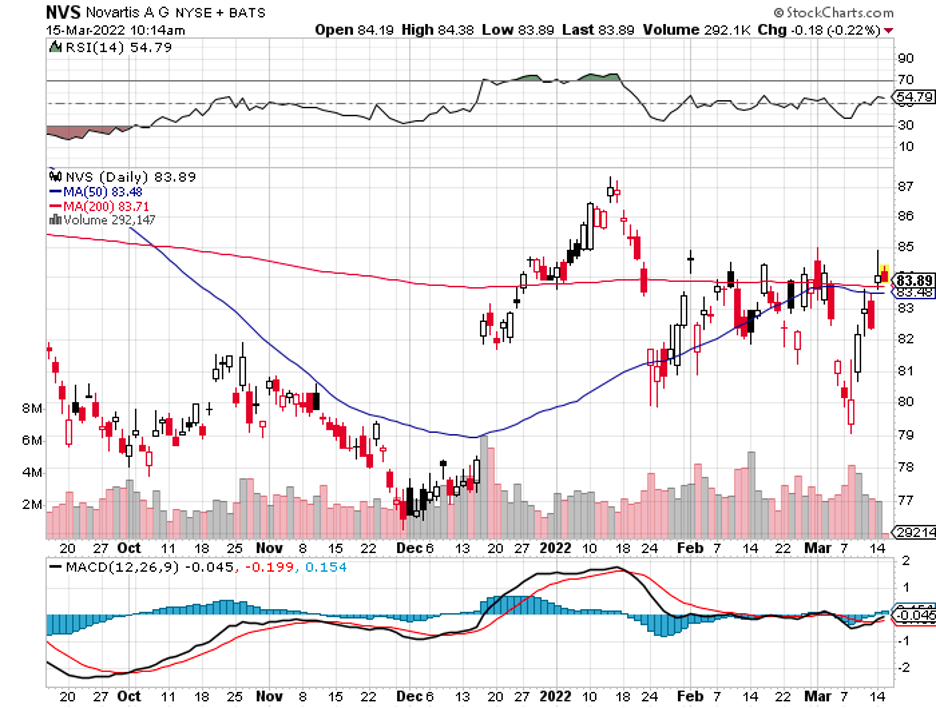The year 2022 marked the time fear made a comeback to Wall Street.
Since the year began, we’ve been plagued with fears over Russia’s invasion of Ukraine, constant threats of high inflation, and the possibility of a recession.
There’s even the fear of major corrections among overheated stocks that could drag the entire market along with it.
Nevertheless, it’s critical to bear in mind that what we have is a market of stocks rather than a stock market.
Although the S&P has been unstable and the Nasdaq continues to be riddled with corrections, we can still be confident that value stocks and, of course, dividend stocks are faring much better.
Truth be told, that’s hardly surprising since value stocks typically outperform the market even in the most challenging periods.
Moreover, the highest-quality stocks tend to deliver the best performance.
When it comes to high-value stocks, one of the defensive, low volatility names that constantly crops up is Novartis (NVS).
To date, Novartis is considered as one of the Big Pharma companies globally, with a staggering market capitalization of $224 billion.
Recently, Novartis has become more aggressive in diversifying its lineup—a strategy that showed tremendous payoffs.
After all, one of the competitive edges of Novartis is its solid profitability compared to its peers, which is primarily driven by the company’s well-balanced portfolio.
For years, the company has been widely known for its oncology treatment portfolio, which was strengthened by its eventual collaboration with Incyte (INCY).
Apart from cancer, it has so far succeeded in developing treatments for cardiovascular, immunology, and even blood disorders.
Its current portfolio of drugs generated impressive revenue despite the economic slowdown over the past months.
For example, psoriatic arthritis drug Cosentyx, which is AbbVie’s (ABBV) top-selling Humira’s biggest competitor, raked in $3.5 billion in sales last year, showing off a 20% increase year-over-year, while myelofibrosis treatment Jakavi reported a 23% jump to reach $1.2 billion.
Meanwhile, heart failure treatment Entresto recorded an impressive 46% climb year-over-year to reach roughly $3 billion.
Aside from these, Novartis has a promising pipeline. Thus far, it has 54 programs queued for Phase 3 trials.
Even if we assume that the company only achieves a 50% success rate, these new products could still add substantial revenue streams within the next few years.
Further leveraging its size and capital, Novartis has been searching for avenues to expand its in the biotechnology market.
Its latest move towards this direction is a license option agreement with Voyager Therapeutics (VYGR).
Novartis has long been on a perennial search for revolutionary therapies to take under its wing, and this deal with Voyager appears to be an excellent opportunity for both companies.
In a nutshell, the two companies have agreed to collaborate on gene therapy programs for adeno-associated virus capsids.
This biobucks deal sees Novartis paying Voyager $54 million upfront, with the possibility of shelling out up to $1.7 billion in several milestone payments and royalties.
The agreement covers three programs targeting the central nervous system plus potentially two more after 12 months.
In addition, Novartis will be granted access to Voyager’s proprietary RNA-based screening platform used to deliver the payload in gene therapy-based treatments.
Another biotechnology-related venture for Novartis is its deal with Carisma Therapeutics.
Following its success with the COVID-19 vaccine production for Pfizer (PFE) and BioNTech (BNTX), the Big Pharma company entered another contract manufacturing agreement with Carisma Therapeutics.
In this deal, Novartis will handle the manufacture of Carisma’s HER2-targeted CAR-M cell therapy, which is under development for the treatment of solid tumors and is slated to be submitted for approval in 2023.
Other than Carisma, Novartis also signed an initial manufacturing deal with CureVac (CVAC) and Roche (RHHBY) in 2021.
Overall, this makes Novartis a relatively safe and low-risk play in the biotechnology and healthcare sector.

